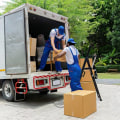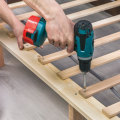Moving can be a stressful and expensive process, especially when it comes to packing and unpacking your belongings. Many people opt to hire professional movers to handle this task, but this can add significant labor costs to your overall moving expenses. However, there is a solution that allows you to pack and unpack at your own pace while also saving money on labor costs: renting a moving container for storage. This option gives you the flexibility to take your time with packing and unpacking, without the pressure of adhering to a strict moving schedule.
In this article, we will explore the benefits of packing and unpacking at your own pace and how it can help you save money during your move. So if you're looking for inexpensive solutions for your upcoming move, keep reading!Moving can be a costly endeavor, but there are ways to save money. If you're searching for information on 'moving 4 less', chances are you're looking for budget-friendly options and tips to make your move more affordable. One effective way to do this is by packing and unpacking at your own pace, which can significantly reduce labor costs.
Not only does it save you money, but it also allows you to have more control over the process and reduces the stress of trying to meet strict deadlines. So, what are the benefits of packing and unpacking at your own pace? For starters, you won't have to hire professional packers, which can be quite expensive. By doing it yourself, you can save on labor costs and use that money for other expenses related to your move. Additionally, packing and unpacking at your own pace gives you the freedom to organize your belongings in a way that makes sense to you, rather than trying to follow someone else's system. Now, let's dive into the steps of how to pack and unpack efficiently. The first step is decluttering.
Before you start packing, take some time to go through your belongings and get rid of anything you no longer need or want. This will not only make the packing process easier, but it will also save you from moving unnecessary items to your new home. Next, it's important to organize your belongings before packing them. This means grouping similar items together and labeling them accordingly. For example, all kitchen items should be packed together and labeled as such.
This will make unpacking much easier and less chaotic. When it comes to packing supplies, you don't have to spend a fortune on fancy boxes and packing materials. You can save money by using items you already have, such as suitcases, duffel bags, and plastic bins. You can also ask friends and family for any spare boxes they may have. Just make sure to reinforce them with packing tape. Finally, when packing fragile items, it's important to take extra care to prevent damage.
Use plenty of bubble wrap or packing paper to wrap each item individually. You can also use towels, blankets, or clothing to provide extra cushioning. Make sure to label these boxes as fragile and mark them with an arrow pointing up so that movers know which boxes need to be handled with care. In conclusion, packing and unpacking at your own pace is a cost-effective solution for those looking to save on labor costs during a move. By following the steps outlined in this article, you can efficiently pack and unpack your belongings while also reducing stress and having more control over the process.
So, don't hesitate to take on this task yourself and enjoy the savings it can bring.
Properly Packing Fragile Items
When it comes to moving, one of the biggest concerns is how to properly pack and protect your fragile items. These delicate belongings, such as dishes, glassware, and electronics, require extra care and attention to ensure they arrive at your new home in one piece. But with a little planning and the right techniques, you can keep your breakables safe and save on labor costs. First and foremost, it's essential to use sturdy packing materials. This includes boxes specifically designed for moving, bubble wrap, packing paper, and packing tape.Avoid using old or worn-out boxes, as they may not provide enough support for your fragile items. Next, make sure to wrap each item individually with bubble wrap or packing paper. This will help cushion the item and prevent any damage during transport. For dishes and glassware, use dish boxes with dividers to keep them separated and secure. Another important tip is to fill any empty spaces in your boxes with packing material. This will prevent items from shifting and potentially breaking during the move.
Be sure to label boxes with fragile items clearly so that movers know to handle them with care. Lastly, consider hiring professional packers if you have a large number of fragile items or are unsure about how to properly pack them yourself. They have the experience and expertise to ensure your breakables are packed safely and efficiently.
Essential Supplies for Packing
When it comes to packing and unpacking at your own pace, having the right supplies is essential for a smooth and efficient move. Not only will having the proper materials save you time and stress, but it can also help save on labor costs.Boxes:
The most basic and crucial item you'll need for packing is boxes.Be sure to have a variety of sizes on hand to accommodate different items. You can purchase boxes from a moving supply store or look for free boxes at local grocery or retail stores.
Packing Tape:
Don't forget to have plenty of packing tape to secure your boxes. Look for heavy-duty packing tape that will hold up during the moving process.Packing Paper or Bubble Wrap: To protect your fragile items, invest in packing paper or bubble wrap. These materials will provide cushioning and prevent any breakage during transportation.
Markers:
Labeling your boxes is essential for staying organized during the packing and unpacking process. Make sure to have permanent markers on hand to clearly mark the contents and destination room of each box.Furniture Covers: If you're renting a moving container for storage, you'll want to invest in furniture covers to protect your belongings from dust and debris. You can also use these covers for larger items like mattresses or sofas that won't fit in boxes.
Dolly or Hand Truck:
Moving heavy furniture and boxes can be physically taxing and time-consuming. Consider renting or purchasing a dolly or hand truck to make the process easier and faster.Efficient Packing and Unpacking Strategies
Moving can be a daunting and expensive task, but with the right strategies, it doesn't have to break the bank.One effective way to save on labor costs is by packing and unpacking at your own pace. Here are some tips on how to do it right. Start by decluttering and organizing your belongings. This will not only make the packing process easier, but it will also help you determine which items are essential and which ones you can do without.
Consider donating or selling items that you no longer need to lighten your load and potentially earn some extra cash. Next, invest in quality packing materials. This may seem like an added expense, but using sturdy boxes and packing materials can save you from potential damages and the need for re-packing. You can also save money by asking friends or family for spare boxes or checking with local businesses for free boxes.
When it comes to packing, start with non-essential items first. Pack them in boxes labeled with their contents and the room they belong in. This will make unpacking much easier and more organized. Don't overpack your boxes to avoid them from becoming too heavy and potentially causing injuries during the moving process.
Fill empty spaces with packing paper or bubble wrap to prevent items from shifting during transit. As for unpacking, prioritize the essentials first. This includes items that you will need immediately, such as toiletries, a change of clothes, and important documents. Take your time unpacking and organizing your new space.
There's no rush, and doing it at your own pace can save you from hiring professional unpacking services. By following these efficient packing and unpacking strategies, you can save on labor costs and make your move more budget-friendly. Remember to also use proper lifting techniques and take breaks when needed to avoid any injuries. Happy packing!
Benefits of Packing and Unpacking at Your Own Pace
Packing and unpacking at your own pace is a smart and cost-effective solution for anyone looking to save money during a move.By taking the time to pack and unpack yourself, you can avoid costly labor fees and have more control over the moving process. One of the main benefits of packing and unpacking at your own pace is the ability to work around your schedule. When hiring professional movers, you often have to work within their availability, which may not always align with yours. This can result in rushed packing or unpacking, leading to potential damages to your belongings and additional costs. With packing and unpacking at your own pace, you have the flexibility to work at your own speed. You can take breaks when needed and ensure that all of your items are packed and organized properly.
This can save you from the stress of trying to get everything done in a short amount of time. Another reason why packing and unpacking at your own pace makes sense is the potential savings on labor costs. By doing the work yourself, you eliminate the need to pay for professional packing services. This can result in significant savings, especially if you have a large volume of items to pack and move. In addition, when you pack and unpack yourself, you have more control over how your items are handled. You can ensure that fragile items are packed carefully and labeled properly for easy unpacking. This can save you from the stress of trying to get everything done in a short amount of time. Another reason why packing and unpacking at your own pace makes sense is the potential savings on labor costs. By doing the work yourself, you eliminate the need to pay for professional packing services. This can result in significant savings, especially if you have a large volume of items to pack and move. In addition, when you pack and unpack yourself, you have more control over how your items are handled. You can ensure that fragile items are packed carefully and labeled properly for easy unpacking.
This can also help prevent any damages during the moving process. Overall, packing and unpacking at your own pace offers numerous benefits for those looking to save on labor costs during a move. It gives you more control over the process, allows you to work around your schedule, and can result in significant savings. Consider this cost-effective solution for your next move and see the difference it can make. In conclusion, packing and unpacking at your own pace is a great way to save money during a move. By following these tips and strategies, you can make the process more affordable and less stressful.
Whether you're moving across the country or just down the street, this cost-effective solution is worth considering.


